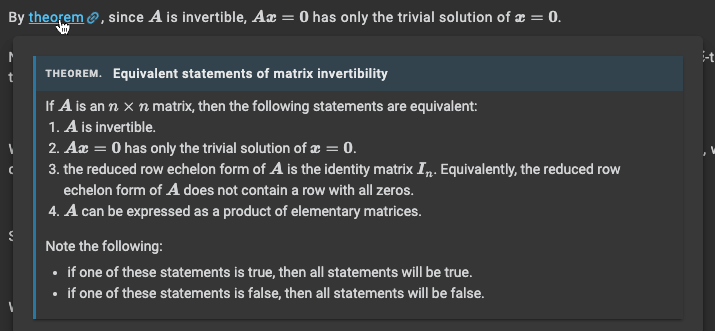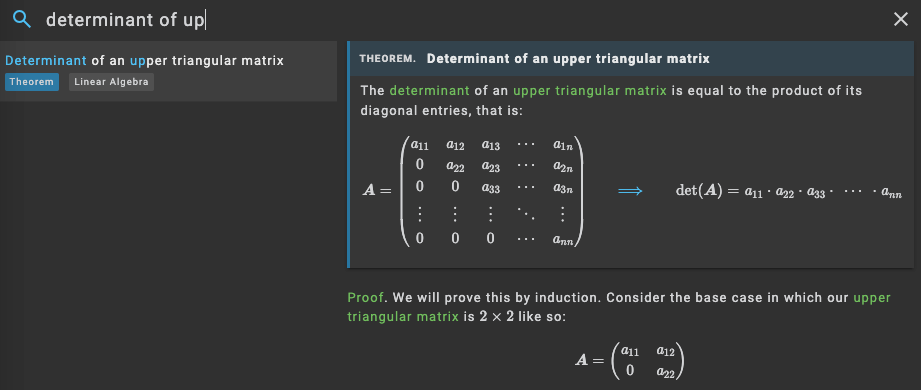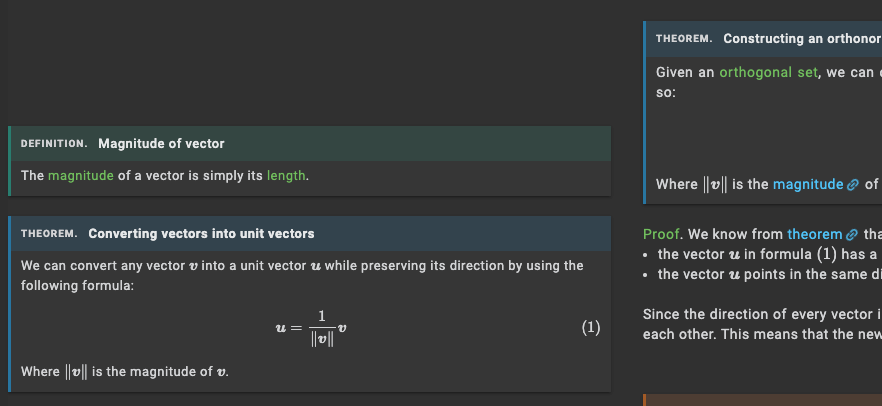account_circle
Profile
exit_to_app
Sign out
search
keyboard_voice
close
Searching Tips
Search for a recipe:
"Creating a table in MySQL"
"Creating a table in MySQL"
Search for an API documentation: "@append"
Search for code: "!dataframe"
Apply a tag filter: "#python"
Useful Shortcuts
/ to open search panel
Esc to close search panel
↑↓ to navigate between search results
⌘d to clear all current filters
⌘Enter to expand content preview
Doc Search
Code Search Beta

SORRY NOTHING FOUND!
mic
Start speaking...

Voice search is only supported in Safari and Chrome.
Learn the Foundational Topics for Data Science
Academic rigor of an undergrad textbook
but with less bloat and more intuition
but with less bloat and more intuition
Web Platform Subscription
$89.9 per year
doneAccess to all content
doneIncludes 2 ebook downloads per year
doneDashboard to track learning progress
doneInteractive map to visualize topic dependencies
doneSearch for defs, theorems and articles
Start my 3-days free trial
(no card required)
Digital ebook
$19.9 per ebook
donePermanent ownership of ebook (PDF)
doneOne year of free content updates
doneOnly $5 to renew content
doneOffered in light/dark/custom theme
Buy an ebook
(Refundable within 14 days)
Start my 3-days free trial
(no card required)
Get an e-book for only $29.9 $19.9
(limited-time beta discount)
Here's a sneak-peek of our ebooks
near_me
Linear algebra
layers
20
guides
article
20
pages
casino
Prob and Stats
layers
20
guides
article
20
pages
smart_toy
Machine learning
layers
20
guides
article
20
pages
function
Misc math topics
layers
20
guides
article
20
pages

Dagster
layers
20
guides
article
20
pages

Pandas
code
20
API
article
20
pages

NumPy
code
20
API
article
20
pages

PySpark
code
20
API
article
20
pages
This ebook is targeted for those looking to build a strong foundation in linear algebra for data science. The ebook has no prerequisite but takes you to advanced undergraduate level - all that's needed for data science. Every theorem comes with a full proof, supplemented with intuitive explanations and diagrams.
Download ebook (preview)
1. Vectors
Introduction
Position vectors
Planes
Dot product
2. Matrices
Introduction
Transpose of matrices
Trace of matrices
Invertible matrices
Elementary matrices
3. Linear equations
System of linear equations
Gaussian Elimination
Pivot positions and columns
Linear dependence and independence
Linear transformation
4. Matrix determinant
Introduction
Determinant of elementary matrices
Invertibility, multiplicative and transpose properties of determinants
Laplace expansion theorem
Cramer's rule and finding inverse matrix using determinants
Geometric interpretation
5. Vector space
Subspace
Relationship between pivots and linear dependence
Spanning Set of a vector space
Basis vectors
Constructing a basis for a vector space
Null space
Column space
Rank and nullity
6. Special matrices
Symmetric matrices
Triangular matrices
Diagonal matrices
Block matrices
LU factorization
7. Eigenvalues and Eigenvectors
Introduction
Basic properties
Eigenspace and eigenbasis
Similar matrices
Diagonalization
Algebraic and geometric multiplicity
8. Orthogonality
Orthogonal projections
Orthonormal sets and bases
Orthogonal complement
Orthogonal matrices
Least squares
Gram-Schmidt process
9. Matrix decomposition
QR decomposition
Orthogonal diagonalization
Positive definite matrices
Schur's triangulation theorem
Cholesky decomposition
Singular value decomposition
Data compression using singular value decomposition
We're not just another math course
Most DS courses either:
- gloss over the technical details, or
- throw complex math equations without explanation
We achieve the best of worlds by deep-diving into the technicality while developing your intuition with:
format_list_numberedstep-by-step proofs
diagrams
simple examples
Theorem.
Product of block matrices (3)
Suppose we have two block matrices where each matrix is composed of four sub-matrices. The product of the two block matrices is:
Note that the shape of the matrices must match for the matrix product to be valid. For instance, the number of columns of
We're not just another math course
Our courses offer a unique blend of technicality and intuition, providing you with a deep and satisfying understanding of data science.
format_list_numbered
Step-by-step proofs
local_library
Insightful diagrams
layers
Simple examples
Elevate your learning experience
priorityRigorous content
We dive deeper into the technical details than any other online course.
boltEvery theorem is proven
We offer an intuitive step-by-step proof for every theorem - no exceptions!
mediationBeginner-friendly
We go from basic high school to advanced undergraduate mathematics.
boltBlazing-fast search
Find definitions, theorems and topics using our search engine without navigating to a new page!
mapInteractive map
Visualize the connections between the math topics. Track your learning progress and complete the map!
helpAsk questions
Need help understanding the content? Ask us questions and clarify your doubts!
Instant content preview
Hover over a link to instantly see a preview of the page - no need to open up a new tab!

Instant search
Find definitions, theorems and topics using our search engine without navigating to a new page!

Side-by-side references
Show linked definitions, theorems and examples on the left side panel for reference!

Meet the team

Obtained a bachelors at UTokyo, a masters of DS at HKU, and now working as a MLE. I'm mainly in charge of the tech-side of SkyTowner, and I love writing articles about data science!

Graduated from UTokyo, and now working in the finance industry. I consider myself a citizen developer and write about topics as they come!
Eva

Graduated from HKUST, and now brushing up my programming skills. I enjoy documenting my learning process on SkyTowner!
Subscription
$69.9 per year
doneDashboard to track learning progress
doneInteractive map with progress tracker
doneSearch for defs, theorems and articles
doneSide-by-side refs to defs and theorems
doneLive-preview of content on hover
doneAsk questions when stuck
doneEvery article loads in <300ms
doneNo ads
Start my 3-days free trial
(no card required)
Digital e-book
$19.9 per book
donePermanent ownership of e-book (PDF)
doneStructured PDF with working TOC
doneOne year of free content updates
doneOnly $5 to renew content
doneOffered in light/dark/custom theme
doneNo ads
Buy an e-book
(Refundable within 14 days)
FAQ
Why should I pay if other resources are free?
We emphasize on the quality of your education - you'll learn much faster and deeper with our guides than you would by reading through some blog post.
I'm not good at math. Is SkyTowner right for me?
Our guides are beginner-friendly and we have lots of diagrams and examples to help you grasp abstract concepts! Also, we'll do our best to help if you get stuck!
Is your content AI-generated?
All content is human-generated - even the API documentations!



